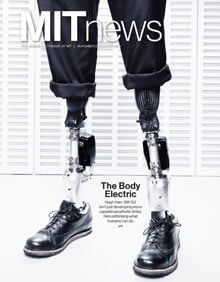Letters
The Rehabilitation Engineer
Of the many brilliant scientists in the world, those with real passion that drives them to realize their highest goals have the greatest impact. Professor Hugh Herr is one (“The Body Electric,” November/December 2014). A biophysicist and engineer with an outstanding laboratory, Hugh has been building robots for a long time—in particular, robotic legs. Most such projects stay in the laboratory for years and rarely advance to the market. However, Hugh’s passion has led to a huge first for our field of rehabilitation engineering: he has designed, built, and taken to market the first powered ankles for people with lower-limb amputations.

This is an enormously hard technical challenge. The human ankle is an amazingly efficient and powerful “device” with incredible control and an unbeatable power supply—the human body. To even come close to matching this performance took years of research, development, clinical insight, and intelligent trade-offs. And then the device had to be hardened for everyday use and pass difficult safety tests (errors can cause catastrophic falls).
Hugh has overcome all these challenges to create the iWalk robotic prosthesis and his company BiOM. The iWalk is the first commercial device to replace some of the power of the ankle, which is so critical to mobility, and has now been fitted to hundreds of amputees—including Hugh himself. As a scientist I’ve enjoyed seeing Hugh develop robots for years, and as a physician. I look forward to his future creations.
Todd Kuiken
Director, Center for Bionic Medicine Rehabilitation Institute of Chicago
Chicago, Illinois
Grace Under Pressure
It was a genuine pleasure to read Grace Young’s report on her experiences living underwater as part of Fabien Cousteau’s Mission 31 expedition (“Grace Undersea,” November/December 2014). With Dr. Mark Patterson, I served topside as science advisor for the mission and helped to oversee the research being conducted by the aquanauts and the surface science team from Northeastern University. As is evident from the piece, Grace’s enthusiasm for science is infectious, and her skills in communicating the excitement of exploration are phenomenal.
I know from my own experience on previous Aquarius missions that living and working on the bottom of the sea can be arduous, which highlights just how impressive Cousteau’s team was in accomplishing the equivalent of many months—possibly even years—of data collection in a comparatively short time.
Like so many of my generation, I was inspired to explore the depths of the ocean by Fabien’s grandfather, Jacques Cousteau. As the father of two young daughters, I am grateful that there are role models like Grace for the next generation of scientists and explorers.
Brian Helmuth
Professor and director, Sustainability Science and Policy Initiative
Northeastern University Marine Science Center
Nahant, Massachusetts
Grace Young’s work with mission 31—and her efforts to share the mission’s underwater research through social media—will no doubt inspire the next generation of researchers. And that important work reflects the achievements of three generations of MIT engineers and aquatic explorers.
Harold “Doc” Edgerton, SM ’27, ScD ’31, best known for perfecting the electronic flash and high-speed photography, collaborated with Jacques Cousteau to conduct oceanic research and to search for shipwrecks with side-scan sonar. After seeing Doc’s amazing high-speed photos in Lifemagazine, I was inspired to use my limited high school budget to make a flash and start taking my own high-speed photos. A few years later, I wrote to Doc and sent him one of my photos: a golf ball squished by the driver’s impact.
When I got to MIT and took 6.163 (strobe lab), I asked Doc if I could use the lab’s image converter camera. He handed me the schematics and a box of spare parts and said, “Maybe you can keep it from burning out so often.” This was Doc at his finest: Figure it out, make it work.
A few years ago, I founded a company to develop an affordable high-speed video camera using high-performance, low-cost electronics. The result was the Edgertronic camera, named in Doc’s honor.
In March, I got a call from Grace Young ’14, asking if the newly introduced Edgertronic could operate at 2.6 atmospheres. She explained the feeding habits of giant grouper fish, the goals of Mission 31 (led by Cousteau’s grandson Fabien), and the reason she wanted to take underwater slow-motion videos. It hadn’t been done before, but it sounded possible if waterproof enclosures were used and if lighting, power, and control issues could be addressed. We donated two production cameras to the Edgerton Center, and Grace worked with Jim Bales, PhD ’91, and other engineers there to tackle those problems. She figured out how to make the camera work on the ocean floor—and that the best way involved standing on her head!
I think Doc would have been impressed.
Mike Matter ’84
Sunnyvale, California
Keep Reading
Most Popular
Large language models can do jaw-dropping things. But nobody knows exactly why.
And that's a problem. Figuring it out is one of the biggest scientific puzzles of our time and a crucial step towards controlling more powerful future models.
The problem with plug-in hybrids? Their drivers.
Plug-in hybrids are often sold as a transition to EVs, but new data from Europe shows we’re still underestimating the emissions they produce.
Google DeepMind’s new generative model makes Super Mario–like games from scratch
Genie learns how to control games by watching hours and hours of video. It could help train next-gen robots too.
How scientists traced a mysterious covid case back to six toilets
When wastewater surveillance turns into a hunt for a single infected individual, the ethics get tricky.
Stay connected
Get the latest updates from
MIT Technology Review
Discover special offers, top stories, upcoming events, and more.